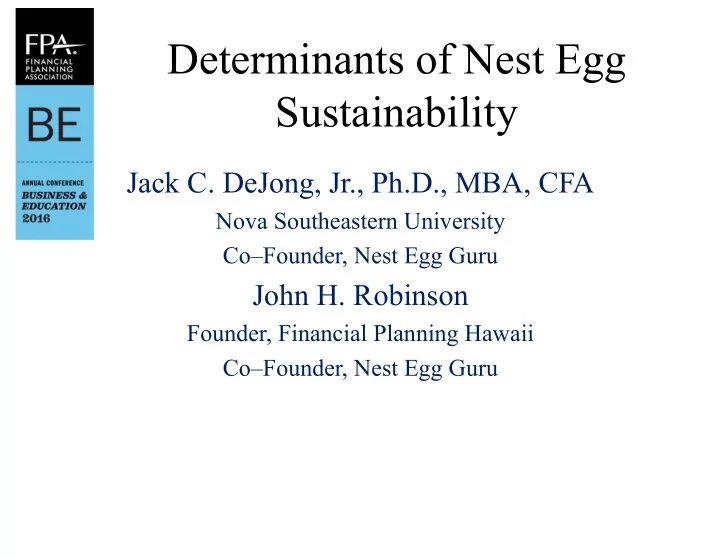

Determinants of Nest Egg Sustainability Jack C. DeJong, Jr., Ph.D., MBA, CFA Nova Southeastern University Co–Founder, Nest Egg Guru John H. Robinson Founder, Financial Planning Hawaii Co–Founder, Nest Egg Guru
Inspiration: Two Seminal Papers • Brinson, Hood, & Beebower, FAJ 1986 – Found that asset allocation was the largest determinant of investment performance. • Bengen, JFP 1994: – Raised awareness of sequence of returns risk. Both had a profound influence on retirement planning. Both have also been misapplied and applied heuristically.
Background: • Over the past quarter century, academic research has examined retirement income sustainability from many different perspectives. • Despite the volume of research there remains a significant gap between the research findings and the practitioner.
Motivation: • Although there has been copious research on retirement income sustainability, few papers have considered the relative influence of various factors that influence sustainability. • This paper seeks to do this, and in doing so to advance the planning profession beyond heuristics, such as the 4% Rule.
Factors Impacting Sustainability: • Time Horizon. • Interest Rates. • Fees and Expenses. • Asset Allocation. • Inflation. • Withdrawal Strategy.
Methodology: • Sample: January 1970 – December 2013. • Four Asset Classes: 45% S&P 500 Index, 30% Russell 2000 Index, 25% MSCI EAFE Index, and Intermediate Term Bonds. • Bootstrapping generates 5,000 simulations using Nest Egg Guru’s Retirement Spending Calculator.
Impact of Time Horizon: • $1,000,000 Initial Portfolio. • Broad Allocation: 60% stocks, 40% bonds. • Intermediate Term Bond Return = 2%. • Inflation Adjustment = 3% per year. • Investment Fees & Expenses = 1%. • Withdrawal Strategy = Constant Allocation with Annual Rebalancing.
Remaining Balances at VaR: Initial 10 years 20 years 30 years Withdrawal Rate 3% 10% = $928,778 10% = $883,506 10% = $629,459 5% = 874,917 5% = $727,405 5% = $375,528 1% = $785,606 1% = $477,258 1% = $0 4% 10% = 789,713 10% = $471,230 10% = $0 5% = 711,593 5% = $327,052 5% = $0 1% = 593,913 1% = $143,231 1% = $0
Impact of Interest Rates: • $1,000,000 Initial Portfolio. • Time Horizon = 30 years. • Initial Withdrawal = $40,000 = 4%. • Broad Allocation: 60% stocks, 40% bonds. • Inflation Adjustment = 3% per year. • Investment Fees & Expenses = 1%. • Withdrawal Strategy = Constant Allocation with Annual Rebalancing.
Assumed Rate of Return on Bonds: Simulation 0% 2% 4% Results Success % 61% 80% 91% Median $192,963 $706,801 $1,382,944 Portfolio Value Bottom 10% $0 $0 $76052 Value Bottom 5% $0 $0 $0 Value
Impact of Broad Asset Allocation: • $1,000,000 Initial Portfolio. • Time Horizon = 30 years. • Initial Withdrawal = $40,000 = 4%. • Inflation Adjustment = 3% per year. • Intermediate Term Bond Return = 2%. • Investment Fees & Expenses = 1%. • Withdrawal Strategy = Constant Allocation with Annual Rebalancing.
Broad Allocation: Simulation 100% 80% 60% 50% Results Stock Stock Stock Stock Success % 95% 91% 80% 66% Median $4,116,844 $2,003,705 $689,536 $280,039 Portfolio Value Bottom 40% $3,145,978 $1,504,182 $450,806 $99,668 Value Bottom 20% $1,433,270 $589,912 $0 $0 Value Bottom 10% $556,123 $56,055 $0 $0 Value
Impact of Inflation: • $1,000,000 Initial Portfolio. • Time Horizon = 30 years. • Initial Withdrawal = $40,000 = 4%. • Broad Allocation: 60% stocks, 40% bonds. • Intermediate Term Bond Return = 2%. • Investment Fees & Expenses = 1%. • Withdrawal Strategy = Constant Allocation with Annual Rebalancing.
Assumed Annual COLA: Simulation 0% 1% 2% 3% Results Success % 100% 99% 93% 79% Median $1,976,062 $1,649,277 $1,215,547 $693,573 Portfolio Value Bottom 40% $1,704,976 $1,384,210 $960,756 $475,857 Bottom 20% $1,180,036 $833,542 $456,458 $0 Bottom 10% $841,262 $524,955 $141,868 $0 Value Bottom 5% $585,150 $292,404 $0 $0 Value
Impact of Investment Expenses: • $1,000,000 Initial Portfolio. • Time Horizon = 30 years. • Initial Withdrawal = $40,000 = 4%. • Inflation Adjustment = 3% per year. • Broad Allocation: 60% stocks, 40% bonds. • Intermediate Term Bond Return = 2%. • Withdrawal Strategy = Constant Allocation with Annual Rebalancing.
Assumed Annual Investment Expenses as a %: Simulation 0% 1% 2% Results Success % 94% 81% 54% Median Portfolio $1,633,944 $736,942 $57,521 Value Bottom 40% $1,284,430 $491,089 $0 Value Bottom 20% $624,639 $11,884 $0 Value Bottom 10% $212,261 $0 $0 Value
Impact of Withdrawal Strategy: • $1,000,000 Initial Portfolio. • Time Horizon = 30 years. • Initial Withdrawal = $40,000 = 4%. • Inflation Adjustment = 3% per year. • Broad Allocation: 60% stocks, 40% bonds. • Intermediate Term Bond Return = 2%. • Investment Fees & Expenses = 1%.
Withdrawal Strategy: Simulation Spend Constant Simple Spend Results Stocks First Allocation* Guardrail** Bonds First Success % 72% 80% 94% 97% Median $912,593 $730,302 $1,390,418 $4,222,468 Portfolio Value Bottom 40% $401,074 $473,983 $1,101,759 $3,369,795 Value Bottom 20% $0 $1,289 $524,032 $1,747,811 Value Bottom 10% $0 $0 $178,351 $854,500 Value Bottom 5% $0 $0 $0 $282,771 Value
Conclusion: • Low interest rates altered retirement planning paradigm. • Retirees choice of withdrawal strategy is underappreciated. • Other factors affecting sustainability: – Living expenses. – Income taxes. • Questions?
Recommend
More recommend